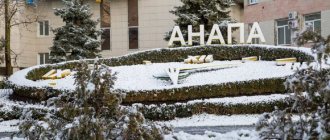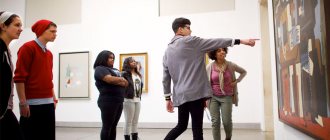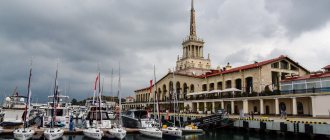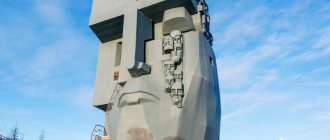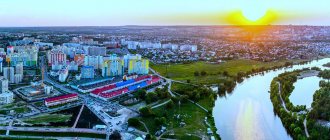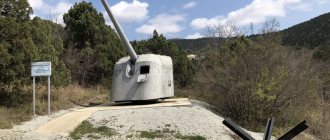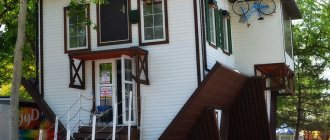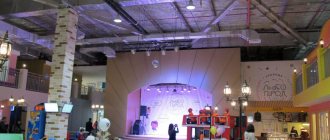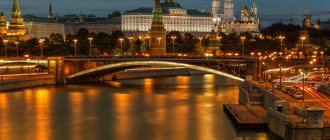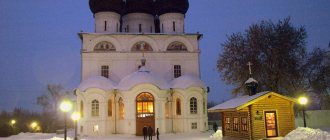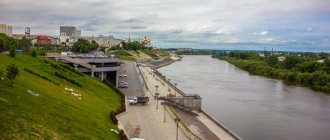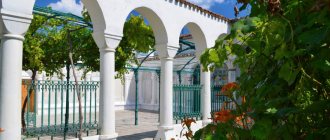Crimea is beautiful for its natural diversity: pebble beaches and greenery of tropical plants on the southern coast, large stones and the gentle horizon of the mountains in the eastern part of Crimea, rocky shores in the area of Sevastopol and Cape Tarkhankut. But today I will tell you about a holiday in Yevpatoria, an ancient city on the west coast.
You will find out who the Scythians, Kenas and Dervishes are and why they whirl. I will share places where you can drink coffee from an old copper pot and eat local “chibireks”. This is the name of chebureks that has been preserved since ancient times. I’ll show you on the map where to rent a bicycle inexpensively and find the purple-yellow-red walls of one-story houses. They will add color to your vacation photos.
Rent a house in Evpatoria →
From antiquity to the present day
The history of the city goes back more than two and a half millennia. At different times, the Black Sea coast was inhabited by ancient Greeks, warlike Scythians, and Ottomans. After Crimea was annexed by Russia in 1783, the city in the southwest was named after the ancient king Evpator. The population was multinational; a Muslim mosque, a synagogue, a Karaite prayer house, Russian and Armenian churches, and a Catholic church were peacefully located on the streets and squares. You can still look at them today, fortunately they are located not far from each other.
Nowadays, Evpatoria is known as a children's resort. In summer, the city's beaches are filled with tourists eager for fun. The city has activities for the whole family - children's attractions, evening discos, night walks by the sea.
In your free time, it’s nice to walk along the beautiful streets, go on extreme hikes, and explore the surrounding area. The city has theaters and museums, and near Evpatoria there are extensive estuaries and salt lakes.
Helpful advice
Save on housing by renting an apartment from a local on Airbnb. Get 2100 rub. as a gift for your first booking.
You can, of course, download videos, photos and descriptions of tourist sites on the Internet and not spend money on excursions. But a real tourist definitely needs to see interesting places with his own eyes, feel the spirit of the times, absorb the smells of the steppe and hear the story of a professional guide.
The main attractions are freely accessible, you can visit them on your own and completely free of charge, and they are easily accessible by public transport. To navigate the area, you will need a detailed map with streets and addresses of tourist sites, a well-thought-out route and your desire.
Look for last-minute tours in the Onlinetours and Travelata search engines. Using these sites, you can instantly compare offers from more than 120 tour operators . Read the secrets of finding the best deals.
This is interesting: Evening and night in Alushta: where to go and where to take a walk
History of Evpatoria in 40 seconds
Geslev Gate / photo by the author
In the 6th century BC, when Sanskrit grammar was created in India, Buddha began to read the first sermons, and the Iron Age began in Europe, Greek settlers from Ionia founded a new city-police on the western coast of the peninsula and called it Kerkinitida . This is the first name of present-day Evpatoria.
For more than two centuries, Kerkinitida existed as an independent state and conducted extensive trade with many cities of the ancient world. At the end of the 4th century BC, the city became dependent on Chersonese, which unexpectedly had a beneficial effect on its development. The thriving polis is home to 2,000 people. A century later, the city was captured by the Scythians, after which the history of Kerkinitida ends, and we still do not know about the development of the polis until the 15th century.
In the 15th century, when China launched expeditions to new lands, the “Great Schism” occurred in the Catholic Church, and in Russia “The Tale of the Massacre of Mamai” was written, and on the site of the former Kerkinitida, the Turks founded the Gezlev fortress. Trade is thriving again in the city, they are beginning to mint their own coins, and trading in slaves is the main source of income for the feudal lords.
Evpatoria on the map of Crimea / OSM
The Ottoman Empire dominates until Catherine II takes Gezlov. The fortress cannot be preserved, but the entrance city gate remains, which can be seen today, and several architectural monuments (I’ll tell you about them a little later).
The city received a new name under Catherine II after the Russian-Turkish War and the annexation of Crimea to Russia.
At the beginning of the 20th century, Evpatoria became a famous resort. Mud baths and sanatoriums are opened here. Mothers with children and elderly couples come.
During the Great Patriotic War, events took place in captured Evpatoria, the memory of which is now preserved by the monument to the Evpatoria Landing . In December 1941, the USSR besieged the Kerch Peninsula. To distract the Wehrmacht forces, they take a tactical move and send a landing party of 700 people to the west coast. There is no way to survive after the operation, and the Red Army soldiers understand this. Instead of the expected two days, Yevpatoria was held for almost a month. The entire landing force dies.
Today, Yevpatoria, rich in historical events, is called the city of children, sailors and merchants. In its vicinity there are youth camps, and in the city itself there is a port.
Back to the past
What should a tourist see when visiting Evpatoria for the first time? Even an ordinary walk around the city can become an exciting adventure. Especially if you know where to go first. So, the main historical attractions of the city:
- The Old Town is the most famous tourist area of Evpatoria. Of particular interest is Karaite Street, where cobbled streets lead to houses of worship - Karaite Kenassa. In addition to them, there is an ethnographic museum and a restaurant serving national cuisine.
- Dervish Temple - the monastery of wandering monks (XV century), the oldest religious building. The mosque, minaret, and the main monastery hall with cramped monastic cells have been preserved. Reviews from tourists note the special energy of this place.
- , the port city of Gözlev was sheltered behind fortress walls with five gates. Today, only one gate of the Wood Market Tower has survived.
- Turkish baths , despite their ancient age (XVI century), were used for their intended purpose until 1987. After cosmetic renovations, you can only get here with a tour group.
- Church of St. Elias is a functioning church, built in 1911-1918. An impressive building with a three-tier bell tower. Connoisseurs admire the graceful Greco-Byzantine style. The spectacular night lighting is especially impressive.
- Juma Jami is a multi-domed mosque (1552), shell rock and limestone were used in construction. The remains of Turkish military leaders rest in the Necropolis to this day.
- The Yegie-Kapai Synagogue is a Jewish house of prayer that is still in operation today. The building is decorated with a round window with the star of Moses, ornamentation and stone carvings under the roof. There is a cafe in the courtyard that serves unusual Jewish dishes.
- St. Nicholas Cathedral amazes with its grandeur and beauty. Construction was completed in 1899. Today it is a functioning temple that can accommodate up to 2,000 people.
- The Armenian church is an exact copy of the famous church in Feodosia, where Aivazovsky was married.
For those who would like to see all the sights in the Old City area in one day, a walking route has been developed - Little Jerusalem. This includes all the objects listed above plus the City of Craftsmen, representing national crafts.
We look at the temples of Evpatoria
Cathedral of St. Nicholas the Wonderworker
1893, Orthodoxy
Orthodox Cathedral in Yevpatoria / photo by the author
The first Orthodox church in the city was built by the Greeks. Almost four centuries later, Christians continue to come to this place to pray. Nowadays there is a majestic cathedral here, consecrated in the name of the patron saint of all sailors, merchants and children (and this is still the main population of Evpatoria), St. Nicholas the Wonderworker.
Juma-Jami Mosque
1564, Islam
Rules for women when entering a mosque / photo by the author
Not far from the Orthodox church there is an even more ancient structure. The mosque was erected by the chief architect of the Ottoman Empire, who lived for 99 years and was a mathematician, engineer and astronomer. The great architect's name was Khoja Mimar Sinan Agha. The mosque is still in operation and has four entrances. The eastern entrance, which was intended for the khan, was opened for the last time 100 years ago, when Emperor Nicholas II entered Juma-Jami.
You can tour the mosque - at the entrance, tourists are explained the rules of conduct and given special clothing. On Tuesdays entry is closed to non-believers.
Yeghia Kapay Synagogue
1912, Judaism
Synagogue, Evpatoria / photo by the author
There is a Jewish synagogue 100 meters from the mosque. The altar is located in the east, towards Jerusalem. Above the six-pointed Star of David are depicted Old Testament symbols: the Ark of Moses and the tripod for sacrifices.
The synagogue is open on schedule. In front of the entrance are kippahs, the traditional head coverings that men are required to wear before entering the synagogue.
Nearby there is a cafe with Jewish cuisine, where you can see signs with the inscriptions: “Promotion: buy two cups of coffee and buy a third one”, “If you throw ten-ruble coins into the fountain, the likelihood of your wishes coming true is higher.” The souvenir shop sells red thread from Jerusalem.
There is a Small Wailing Wall on the territory, where people leave notes with their wishes and requests. All messages, according to ministers, are sent monthly to Jerusalem.
Karaite kenas
1818, Karaism
In Yevpatoria there is a functioning temple complex of the Karaites, a small people of Crimea. There are about 2000 people in the world.
The Karaites are the descendants of the Turkic tribes of the aboriginal population of the peninsula. The formation of the ethnos began in the 8th century. The Karaite community was formed in Evpatoria in the 16th century, and two centuries ago the Evpatoria kenas became the only spiritual center of the Karaites in Russia.
Karaism is a monotheistic religion limited to the books of the Holy Scriptures of the Old Testament. Karaites are convinced that the Law of God is perfect and does not need interpretation. Services are conducted in biblical (Hebrew) language. Now the complex houses an ethnic cafe and an excursion center.
Armenian Church of Surb Nikoghayos
1837, Apostolic Church of Armenia
The temple, which now belongs to the Armenian community, was built two centuries ago. During its eventful history, it has been an archive and a home for the disabled.
In the courtyard there is a carved stone cross, carved from tuff, which has sacred meaning for the Armenian people. This is a symbol not only of faith, but of the eternity of national culture, as well as a prayer embodied in stone. The temple is operational.
Temple of St. Elijah
The temple is located right on the embankment. Refers to buildings in the Greco-Byzantine style. The building is shaped like a cross. The facades of the temple look simple; the most striking decoration is the stained glass windows. The bell tower, consisting of three tiers, attracts attention.
City attractions
After immersing yourself in antiquity, it will be nice to take a walk through the streets. The city's top attractions include:
- Embankment named after Gorky with shops, restaurants, exquisite buildings, stylish lanterns, openwork gates, snow-white colonnades;
- observation decks , which offer the best views of the sea and the city;
- statue of Hercules resting on the shore, on the way to the park. Frunze;
- park "Crimea in Miniature" , which brought together the most famous sights of the peninsula in one place;
- Embankment named after V. Tereshkova - a popular promenade along the sea bay, where the best cafes and restaurants, “dry” fountains, and a yacht club are located;
- Theater Square , which housed the theater named after. Pushkin, the main library, a monument to S. Duvan - the mayor of Evpatoria at the beginning of the 20th century.
It is impossible not to mention the famous beaches of Yevpatoria, stretching for many kilometers. Admission to them is free. The exception is private areas near hotels and sanatoriums.
Beaches
- The central beach is about 2 km long, half of which belongs to sanatoriums. It is very crowded here during the season.
- Robinson is a compact sandy beach, located slightly away from Central.
- The Cote d'Azur is one of the best beaches in Evpatoria, located near Lake Moinak. Is paid. But the entrance price is quite small. Nearby there is another good beach - Rodnichok.
- Towards Simferopolskaya Street you can find several excellent sandy beaches: Oasis, Golden Sands, Solaris.
Children's time in Evpatoria
The status of a children's resort in Crimea somewhat limits the choice of evening entertainment in Yevpatoria. Children are supposed to be active during the day, and the opening time of a nightclub is bedtime for them. But you can still take a walk in the city in the evening with your family – “children’s time” offers some entertainment.
A typical place for a resort promenade is the embankment, Evpatoria is no exception. There are even two embankments here - Gorky and Tereshkova. In the evening the first one is more popular. A walk along it is interesting because you can visit the Alley of Fountains, which are beautifully illuminated during the dark period. Otherwise, the pedestrian street offers the usual selection of a resort evening - small cafes, open-air concerts and just a stroll.
If it’s not too late, you can go with your children to the Frunze Park. The attractions there are also open in the evening (but not at night). In addition, at dusk, this entertainment center hosts interesting performances, including an exotic animal show, the “star” of which is an albino crocodile.
What to see in the vicinity of Evpatoria
There are many popular tourist places near Yevpatoria. A visit to the outskirts of the city provides an opportunity to become more familiar with the history and geography of this ancient city.
If you are traveling by private car or relaxing as a wild man on the beaches near Evpatoria, you do not have to go to the city to have a fun holiday.
Water park "Medusa" (temporarily closed)
15 km from Yevpatoria and just 10 km from Saki is the largest water park in Crimea, “Medusa” (temporarily closed). 25 water attractions and 4 large fresh water pools await you. There are many cafes and fast food outlets, a water bar and even a VIP area for quiet relaxation.
For children there is a separate play area with slides, water fungi and a swimming pool, there is even a children's cafe. For the youngest visitors of the water park there is a shallow children's pool
The water park is located right on the seashore on the Simferopol-Evpatoria highway.
If you are staying in guest houses in the city of Saki, you can use the free bus from the bus station to the water park.
Pink lake Sasyk-Sivash
If you are a nature lover, be sure to visit the incredible Lake Sasyk-Sivash. It is located at the entrance to Evpatoria. It is quite easy to get to on foot.
Thanks to the bacteria Dunaliella salina, the water in the lake is bright pink and sometimes pink-orange. There are simply amazing photo sessions here! It is best to go to Sasyk-Sivash towards the end of summer. The most beautiful shots are obtained if you come here closer to sunset.
Pink lake Sasyk-Sivash
Healing Moinak Lake
In addition to the beauty of salt lakes, they have healing properties. Moinak Lake and its mud are widely known to the residents of our country. People come here to treat various diseases.
One of the first mud baths in Russia was once built on Lake Moinaki. The lake water has a beneficial effect on the condition of the skin and joints. With the help of mud baths, serious diseases of the musculoskeletal system are treated.
You can get to the lake by tram or bus from Yevpatoria.
What to do in your spare time
Where to go in Evpatoria? There are many options:
- Local History Museum with exhibits discovered during archaeological excavations;
- The House of Wine is a new tourist attraction with a museum, a shop and a tasting room;
- Theater named after Pushkin - ballet, dramatic performances, musical evenings;
- Theater "Golden Key" - children's productions, creative evenings, acting school;
- Park of living sculptures on the embankment named after. Gorky.
Most recently, a new amusement park, Avangard, opened its doors. You can visit it yourself. Among the attractions: carousels of different levels, trampolines, catapults, labyrinths, rope park, quests. It is located in the Resort Quarter of Evpatoria.
Reviews: an excellent holiday destination for young people, exciting attractions, some of which should not be allowed for children under 10 years old.
Look for interesting excursions in specially trained search engines:
- Tripster - unusual excursions from locals.
- Sputnik - inexpensive group excursions.
Only Russian-speaking guides.
This is interesting: Entertainment for children in Yevpatoria (Crimea): where to go and what to see
Detailed map of Evpatoria with attractions
If you look at the map of Evpatoria and its surroundings, it is all strewn with attractions and places popular among tourists. When going on vacation, you can easily plan your trip in such a way as to see as many interesting things as possible.
Many entertainment and recreation centers in Crimea on the seashore operate year-round. Even in the winter season, Evpatoria is an excellent place for relaxation and recovery.
The best places for photos in Crimea
View more
Interesting facts about Western Crimea
See more
Cultural program for the evening
If adults with high cultural demands come to Evpatoria on vacation, it will not hurt them to study the playbill of the theater in advance. Pushkin. Summer in Crimea is a period for the best bands to tour, so there may be many wonderful surprises in the schedule. It’s better to book tickets in advance - there are a lot of people interested, and the hall is not rubber.
It is much easier to get to one of the city cinemas - “Raketa”, “Maximum Cinema” and others. Evpatoria cinema centers have modern technical equipment and a decent repertoire - there is always something to watch there. In principle, it is possible to purchase tickets “today for today”.
Reviews from principled fans of Evpatoria also recommend evening walks around the historical part of the city. Museums are closed late, there are no tour guides (unless you can hire a private one), but in the evenings the buildings are illuminated and look different than during the day.
Accordingly, the impressions of the walk are different. And the historical center of Yevpatoria with the most important historical and architectural monuments is not so large - you can literally get around everything in one evening.
Crimean connoisseurs also often note that there are many coffee shops in Old Yevpatoria - specifically with coffee and desserts, with a minimum of alcohol. Such a place can provide an exceptional stop during a walk.
Theaters and museums
Museum and theater lovers will be interested in seeing:
- city theater named after Pushkin;
- local history museum;
- Museum Pirates of the Black Sea.
Pushkin Theater
Theater stage
At the beginning of the last century, a theater building was built in the city, which many associated with the Opera House in Odessa, built a little earlier. Today it is also one of the most beautiful buildings in Evpatoria.
It's not just the architecture that attracts tourists' attention. Everyone will be able to come to theater performances, comedy numbers, ballet and children's performances.
Mostly touring bands perform on stage. Quite often there are musical evenings or exhibitions.
Museum of Local Lore
Exhibits of the museum
It was opened in 1920. Throughout its existence, it has been located in the same building - a luxurious mansion that belongs to a local merchant.
Previously, the house was considered the most interesting building in the city. When they see the museum, tourists immediately appreciate its appearance, reflecting the Arabic style. There are cannons at the entrance. The museum's collection contains more than 100,000 objects that were found throughout the city throughout the entire period.
Museum Pirates of the Black Sea
Unusual exhibits
It is a very bright, interesting and slightly fabulous place.
In 2013, local youth decided to open an unusual museum in the city, which presents famous heroes and characters. The created environment will allow guests to temporarily feel like pirates.
The exhibits on display relate to different centuries and historical events related to piracy in the waters of the Black Sea. There is a separate corner where you can take themed photos. In total, there are more than 500 exhibits, including archaeological finds, pirate guns, coins and even parts of ships.
FAQ
What temples are worth visiting in Evpatoria?
The city has such famous objects as the Church of St. Elijah, St. Nicholas Church, and the Juma-Jami Mosque.
Tram of Desires
Address: st. Frunze, 1 Opening hours: in the summer, seven days a week from 11.00–20.00 Cost: 50 rubles for adults and 20 rubles for children Duration: 1 hour 20 minutes
The only excursion tram route in Crimea begins in the park named after. Frunze. The tram is equipped with tables, so you can, while eating ice cream and drinking lemonade, listen to the guide: he will talk about the history of Evpatoria, which used to be Gezlev, and even earlier – Kerkitinida.
You will look at the old streets, architectural monuments, embankment, imagine ancient Greeks or Turkish citizens walking around the city, enemies besieging the fortress and military leaders on horseback. The name of the tram was not given by chance - if you step on the footrest with your left foot while holding the handrail with your right hand, your wish will come true.
Karaimskaya street
Leave the embankments for another time to feel the spirit of not a resort, but a historical Yevpatoria. Karaimskaya Street is the pulse of the city, the buildings here, although restored, look ancient, the road is paved with stone.
Street musicians (including oriental ones), vernissage, master classes on clay modeling, blacksmithing, and handicrafts. Of course, in accordance with the best European traditions, there are many cafes and souvenir shops. If you're lucky, you'll see performances of oriental dancers.
Although each house on Karaimskaya Street is an architectural monument in itself, pay attention to the following buildings:
Merchant Synagogue
Address: Karaimskaya, 33
The turbulent history of this building is sad, but with a happy outcome. What we see now is the result of the 2009 reconstruction. A century and a half ago, the first, small synagogue for the Crimean Jewish community was built on this site. After a couple of decades, the community grew, and the synagogue could no longer accommodate everyone. The building was rebuilt twice at the expense of Jewish merchants.
The synagogue received an unprecedented honor - Emperor Nicholas II himself visited it. For the entire 20th century, this is the only joyful event: then, in the chaos of the revolution, wars and under Soviet rule, the sacred building was used and rebuilt for everyday needs, and was gradually destroyed. Now we see the result of the restoration of the building, while maintaining all the requirements for the synagogue.
Karaite kenas
Address: Karaimskaya, 68 Telephone: 8 (6569) 3-30-35 Opening hours: from 08.00–20.00 (summer), 10.00-17.00 (after the end of the season), on Saturdays from 13.00 Cost : 100 rubles.
This is a functioning temple of one of the smallest nationalities in the world - the Crimean Karaites.
Enter one of the three courtyards through a portal entwined with a vineyard, admire the paintings on marble slabs (denoting key events in the life of the Karaites), and sit near the fountain. Go to the small kenasa, the courtyard waiting for prayer and the large kenasa. Since this is an active temple complex, entry inside is possible as part of a tour.
Turkish baths (Hamam)
One of the medieval baths is located at Karaimskaya, 43 , and the hammam is located at neighboring Krasnoarmeyskaya, 20 . In medieval Turkey, baths were a kind of meeting and socializing place, strictly separated by gender - separate entrances for men and women.
The baths operated until 1987, until they were looted - then the marble was removed from the floor and walls, and the buildings began to collapse. Now this is an abandoned building, which you can not only examine from the outside, but also look inside.
The first room (have you forgotten that men and women need to go through different doors?) is the locker room. Here they took off their clothes and put on special sandals and wrapped themselves in a clean sheet. Go down to the rest room - the brick floors here were heated, so it was impossible to walk barefoot. Imagine marble walls and the sound of water pouring from a fountain.
A small room is a steam room, and then there is a washing room, lined with ceramic tiles, and a pool with cold water. Would you like to go to such a bathhouse? They plan to restore it, and perhaps on your next visit you will be able to feel the gentle effect of steam in a real hammam.
Evening beach at the resort
When asked where to take a walk in the evening in Yevpatoria, young tourists risk receiving a banal answer for Crimea - on the beach. Nowadays few people can be surprised by beach parties, but in Evpatoria this business is organized in a special way.
The central city locations here are aimed at sedate family vacationers, and such people do not drink beer in the evenings by the sea. Therefore, for an evening beach program in Yevpatoria you will have to go away from the center.
The place called “Beach No. 1” enjoys the best reputation. During the day, this is a public area with a predominantly youth entertainment program and music, but it is quite convenient for all categories of vacationers.
In the evening, the area turns into an original nightclub with two dance floors, a club show program, foam and a variety of drinks. The sea will be a pleasant addition to the event.
On some other Evpatoria beaches there are also evening events. You need to keep an eye on posters and announcements on local Internet sites.
Holidays in Evpatoria by the sea: throw the bike and run to the beach
Beach season is in full swing / photo by the author
Beach "Central"
A narrow city beach with developed infrastructure and a crowd of tourists attached to it.
This is the most popular beach in the city. Located next to the seaport. It stretches from Frunze Park to Duvanovskaya Street. The beach is narrow (about 30m), but flat, suitable for families with children. The absence of waves and white sand are popular with tourists. Smoking is prohibited on the beach and cleaning is carried out frequently. The beach is rich in infrastructure, there is entertainment in the form of slides and attractions.
Solaris Beach
Gentle slope, great for families with children. There are showers, changing rooms, trampolines, water slides, and corn peddlers.
Robinson Beach
The sand is fine. There are showers and sun lounger rentals.
Cote d'Azur
The cleanest beach in Evpatoria is located on the western shore. This place has a gentle and sandy entrance to the sea, so it is convenient to relax here with children. There is protection against jellyfish.
Entrance: 35 rubles, children under 7 years old - free.
Oasis Beach
Private sand and pebble beach, located in the Old Town area. This beach is among the first in Evpatoria for its excellent quality of service.
The entrance is free . There is a VIP zone: 100 rubles, children under 12 years old - free.
New beach
It stretches from Simferopolskaya street, station “54th km” along the highway to Saki-Simferopol to station “Pribrezhnaya”. This is a pebble beach, more suitable for adults. It is almost never crowded. The depth begins close to the shore.
Embankments of Evpatoria
Yevpatoria also differs from other resort towns in that it has twice as many embankments for walking.
Gorky and Tereshkova embankments are similar in that along the road there are shops, tents with bottled wines, and souvenir shops. A loud camp (musicians - dancers - singers) will make you happy on one street and on the other.
If you are planning a boat trip, just go to one of the moored yachts and negotiate with the captain.
On Gorky Embankment there are three rotundas, a sculpture of Hercules and a dolphinarium .
On Tereshkova there is the Juma-Jami Mosque (Revolution, 36), St. Nicholas Cathedral (Tuchina, 2) and St. Elias Church (Buslaev Brothers, 1).
Sights of Evpatoria
What to see in the city, where to go and where it is
Juma-Jami Mosque
If we talk about the most interesting places, then it’s worth taking a look at the pearl of the city - the Juma-Jami Mosque (Friday Mosque) or, as it is also called here, the Khan-Jami Mosque. This majestic masterpiece is a one-of-a-kind piece of 16th-century history. The building itself and its two 35-meter minarets are clearly visible both from the city and from the sea.
The mosque received the name of the Khan's, due to the fact that all 18 rulers of Crimea were crowned Khanate here. The Juma-Jami Mosque is a 22-meter structure resembling a cube; during its construction, the author used a principle similar to the construction of the Constantinople Cathedral of St. Sophia. The top of the mosque is crowned by a dome with a diameter of 11 meters, which supports a drum with large windows.
The main dome is surrounded by eleven more small domes located just below it. From the east and west, the mosque is decorated with minarets, which were destroyed, one in the 16th century, the other in the 19th, and were restored in the 80s. The holy place has several entrances, but it was from the eastern entrance that the khans entered the balcony.
Juma-Jami Mosque
The tier at the top is decorated with multi-colored stained glass windows, which change according to the number of seasons and are a symbol of eternity. Here, until the end of the 20s of the last century, the 15th century Koran was kept, which is now in the Museum of St. Petersburg.
During the existence of the mosque, it was restored and rebuilt many times, and after the revolution it was completely closed and converted into various utility and administrative premises. The mosque was returned to believers in the 90s after a long restoration of the building.
Now it is the largest mosque on the peninsula that receives parishioners. Anyone can also visit it and learn about the history and traditions of Islam. Read about other attractions of Crimea here.
Yeghia Kapay Synagogue
Another monument is the Crafts Synagogue or Yeghia Kapay. This is a very striking landmark of the city; it serves as a house of worship for the Jewish population, but the Jews themselves use this name extremely rarely; in most cases it is called shul or bet ha-Knesset.
Construction of the synagogue began in 1911, the design of which was proposed by A.L. Genikhan, and already next year they held their first service here. The building was built with money from artisans, the city government and Jewish patrons.
Yeghia Kapay Synagogue
The synagogue was built according to all the rules of Jewish architecture. Mamay yellow limestone was used in its construction; masonry technology was followed with the correct change of rows (banding). The synagogue has a rectangular basilica shape with three levels. Two of them have rectangular windows, and the third is round, on which a stained glass Star of David can be seen.
If you look closely, right above it you can see scenes from the Old Testament with an ark with stone tablets, an altar built by Moses at Mount Sinai and the ten commandments engraved. There are several entrances here, where the main entrance is only for men, and women can enter the two side ones for prayer on the second floor
The main shrine in the synagogue is the wall with the altar, where the Torah scroll is preserved. The altar is located near the wall facing Jerusalem, which is considered a prerequisite for all temples for the Jews. In the courtyard of the synagogue there is a kosher restaurant called “Yoskin Kot”.
St. Nicholas Cathedral
St. Nicholas Cathedral (St. Nicholas the Wonderworker) is considered the most spacious temple on the peninsula, surpassed only by the Vladimir Cathedral of Chersonesos. It is analogous to the Hagia Sophia Cathedral of Constantinople. This interesting monument of temple architecture has the appearance of an octagonal building (octagon) with a massive dome made of monolithic concrete.
St. Nicholas Cathedral
The temple is divided by three chapels, in the center of which is the chapel of St. Nicholas of Myra, on the left side is the chapel of Jacob Zebedee, and the right one is dedicated to Prince Alexander Nevsky. Construction of the temple began in 1893 with donations collected from all the religious communities in Yevpatoria and Archpriest Yakov Chepurin; he donated all his savings, valuables and income to the construction of the temple.
The consecration of the cathedral took place in 1899, which the archpriest, unfortunately, did not live to see. After the revolution, the cathedral, like many religious buildings, was closed and given over to warehouses and an art workshop.
During the retreat to the war, our troops were supposed to blow it up, fortunately, this did not happen. In the 90s its restoration began. Unfortunately, all the internal paintings, images, and iconostases were not preserved in their original form; all this was restored in our time.
The cathedral is decorated with three types of crosses: St. George’s crosses are installed on the fence, which reflect the military honor and glory of those who died in the Crimean War.
The columns are decorated with Byzantine crosses, they show the identity of the temple with the Constantinople Church of St. Sofia, but the domes are already crowned with Orthodox crosses.
Cathedral of St. Nicholas is one of the foundations of the city's history. It is clearly visible from the sea and serves as a kind of beacon for sailors.
Karaite kenas
In Evpatoria there is a peculiar street called Karaimskaya, on which there is a one-of-a-kind landmark of the city, Karaite kenas. This temple ensemble is a unique architectural monument of the 18th century of national importance and a relic of the Karaites.
Karaite kenas
After the unification of the peninsula with Russia, Evpatoria became their spiritual center, and in the 19th century, with funds and according to the project of S.S. Bobovich laid the foundation for the construction of the Great Kenasa. Its construction lasted for 3 years, of which most of the time was spent putting the surrounding area in order and finishing the interior of the premises.
Big kenasa
By 1815, opposite the Big Kenasa, which held holiday services, the Small Kenasa was opened. In the early 20s, a midrazh, a spiritual school for boys, was added to the complex, where a kitchen was organized for charitable purposes. The entire ensemble had completely adopted its image by 1900. Its entire area is interconnected by courtyards, each of which has its own purpose.
The entrance from the street is decorated with an elegant portico made in the Renaissance style. From it you immediately enter a green corridor called the Vineyard Courtyard, through which you enter the Ritual and Marble Courtyards, separated by arcades.
Grape yard
Having passed by the column, which is crowned by a double-headed eagle, you enter the Marble Courtyard, which covers the courtyard of Waiting with its pomp. Here, in a cozy garden with a tent covered with grapes, you can get unforgettable peace.
In the Marble Courtyard there are tombstones moved here in the 80s of the last century from the almost destroyed Karaite cemetery. And the Memorial stands as a tribute to the tragedy of the Patriotic War, when in 1942 a large number of Karaite people died here.
Lapidarium
On the southern side there is a gechal, where antique Torah scrolls are kept behind a parahet (curtain) with luxurious embroidery. During all the changes and reconstructions, the most damage was done to the Small Kenase, but after restoration work it was restored to its original appearance and the surviving altar with the crown returned to its original place.
Museum of Local Lore
Another pearl of Evpatoria’s architecture can rightfully be considered the city’s local history museum, which opened in 1921. The mansion given over to the museum previously belonged to the merchant Gelelovich. It is built in a Moorish style, evidenced by horseshoe arches, moldings and carvings.
The cornices are inlaid with geometric shapes, the oak entrance doors have clearly visible ornaments, and the roof has turrets that are actually a well-designed chimney system. After the opening of the museum, almost two thousand exhibits were collected in three months: ceramics, coins, porcelain, carpets, and by 1925 several departments were working here: archeology, atheism, ethnography of production and a resort.
Museum of Local Lore
During the fascist occupation, many items were damaged and looted, and already in 1944 they began to restore it. By 1950, new departments appeared here, and in the late 60s, Karaite kenas, which are an architectural monument of the 18th century, were given to the museum, but then the kenas returned to their intended purpose.
Now in front of the museum there is an exhibition of stone sculptures and archaeological excavations, covered with a glass pyramid, and anyone can see it all. The museum presents exhibitions telling the history of the development of the city, from the settlements of Kerkinitida to the present day. Here you can also see a diorama showing the scene of troops landing in old Yevpatoria.
There are no united episodes on the diorama; they are all separated by time and place, just as it is impossible to see here anyone’s real faces of the heroes of that landing. There were very few such dioramas in the Soviet Union. In front of the museum you can see cannons, one cast in 1877, and the second in 1894. Now the museum houses about 100 thousand exhibits, most of which are documents from the 18th-21st centuries.
Tekie dervishes
Evpatoria is rich in religious buildings. One of these is located at the intersection of Karaev and Internatsionalnaya streets. A modest two-story building, with a gate adjoining on the left, above which is the coat of arms of the Crimean Khanate. Having crossed the threshold of the gate, you find yourself in the most mysterious place in the city, which is called the tekie (abode) of the dervishes, preserved since the Middle Ages.
Tekie dervishes
Dervishes are the followers of the Muslim movement of Sufism. They were highly revered in the east and considered saints. Tekie is both a temple and a home for the dervishes. The exact date of construction of the building has not yet been determined, but it is believed that it dates back to the 15th-16th centuries. Tekie is a building close to a square. Due to the cutting of the corners, the top smoothly becomes an octahedron, covered with a huge dome covered with tiles.
The interior decoration is without any frills, just plastered walls that are not decorated with anything. There are 19 cells where dervishes lived. Not far from the tekie you can see the ruins of the Shukulla Efendi stone mosque, next to which stands a minaret. In the building of the madrasah there is a Tatar ethnographic museum, telling about the life and everyday life of the Crimean Tatar population.
Museum. Armor of ancient warriors
Museum. Chechen and Tatar clothing
After the disappearance of the Whirling Dervishes, the Tekie building was empty for a very long time; restoration began only at the dawn of the new millennium. Today there are a lot of tourists here who are interested in ancient architecture; here you can also learn a lot of interesting things related to the rituals of the dervishes, about their unusual rotations, and listen to their music.
Gözlev Gate
Many centuries ago, Gezlev was a well-defended fortress, which was surrounded by a heavy wall made of durable stone, reinforced with watch and defensive towers. The fortified citadel at that time was equipped with five powerful gates, but only the eastern one has survived to this day.
Gözlev Gate
They were called the Wood Market Gate and served as the main entrance to the fortified city. When a new khan was crowned on the throne, in whose honor prayers were held in Khan-Jami, he, accompanied by his retinue and guards, went through these gates to the Bakhchisarai Palace.
They were built in the 15th century and stood until the end of the 50s of the last century, at the same time surviving two Russian-Turkish wars and numerous sieges of the Zaporozhye Cossacks. But then it was necessary to expand the highway, and the historical monument was destroyed.
They began to be restored from scratch in 2004 by the city using funds from patrons, and yet they managed to bring them back to their original form. The gate has three levels. The second level is occupied by Gezlev Kavesi, a cozy Tatar cafe that serves excellent coffee and national Tatar dishes. The design of the coffee shop is quite interesting; there is a mini-museum with artifacts that will help you understand the history and life of this medieval settlement.
On the third level you already find yourself in a large museum, which represents the old Gezlev and a model of that city. The entire excursion is accompanied by light music simulating the sunrise in old Gezlev. Also from the gates of the Wood Market, the pedestrian route Little Jerusalem begins.
Walking route "Little Jerusalem"
The part where the Old City stands is called Little Jerusalem, for which there is an excursion route called a walking route. This tour route is recommended by UNESCO for inspections and is included in its register. There are ancient monuments and many working temples and mosques here.
Little Jerusalem. Entrance to the Old Town
The route includes temples of seven religions and many other attractions. And you can enter this territory through the Gezlev Gate. Taking a map of attractions with you, you can cover the route yourself, which is worth setting aside a whole day for. Here you can buy souvenirs sold in stalls on Karaimskaya Street, relax and have lunch at Yoskin’s Cat while visiting Egiye-Kapai, or go into the building of the eastern gate and taste the cooking of Tatar craftswomen.
Memorial complex "Red Hill"
There is no person living in Yevpatoria who does not know the “Red Hill” memorial. Here, during the occupation of the city, the Nazis shot almost 13,000 residents. This memorial is called the mass grave of victims of fascist terror; it is the pain and memory of that tragedy.
Construction of the monument began after the end of the war, and in 1969 it was taken under state protection. Now Victory Parades are held at the memorial and tourists visit en masse.
Memorial complex "Red Hill"
The complex is located on a fairly large territory, where there is a place for monuments, the Eternal Flame, military equipment, as well as stands that inform about that terrible tragedy and the feat of the people who lived in this city.
It is better to get here by vehicle, since it is located far from the coast and from the tourist center of the city.
Armenian Church of St. Nikoghayos
As you know, Evpatoria is a city inhabited by people from different nationalities and religions, and the Armenian diaspora is no exception. Not far from the tekie dervishes, on the land of the nursing home, there is the Armenian Church of St. Nikogaios (St. Nicholas the Wonderworker), which is a city architectural monument.
Armenian Church of St. Nikoghayos
The church was founded in 1817 on the site of a church destroyed in old times, the construction of which took a long time due to lack of funding. It was built only in the middle of the 19th century. It was built using white limestone blocks. Initially, the church was in the form of a domed basilica with three naves, covered with vaults, and a semicircular asp on the altar.
On the eastern side, the Khachkar (translated from Armenian as cross-stone) has been preserved. This is a relief cross, the presence of which was the main requirement for Armenian churches.
Khachkar
During the Crimean War, French soldiers were quartered here, and after their departure they left various inscriptions on the walls of the temple. Later, the inside of the church was plastered, its territory was planted with an orchard, and a primary school was built nearby, which later became a parochial school for boys.
During Soviet rule, it was given over to a nursing home, after which all church attributes were destroyed. In 1984, it was elevated to the rank of architectural monuments, and only in 2012, after a long restoration, the church was opened to parishioners.
Temple of St. Elijah
On the city embankment there is a Greek temple, consecrated in the name of the holy prophet Elijah. It was built in 1918 according to the design of architect A.L. Henry. This church is one of the three main attractions of the city, and stands on a par with the St. Nicholas Cathedral and the Khan-Jami Mosque.
The domes of all three temples are clearly visible from the sea. The Temple of the Prophet Elijah in its architecture is very different from the pompous St. Nicholas Cathedral; it is a rather simple structure, the walls of which are made of sawn shell rock. The style of its construction is Greco-Bysatian, so it represents the shape of a cross.
Temple of St. Elijah
The building itself is small in size, but due to the high base it looks large. The octagonal drum is covered with a dome, and each face is topped with pediments. The church itself is decorated with pilasters, stained glass windows and semicircular arches. Above the main dome there is a bell tower of three tiers, which was dismantled back in the 60s, but has now been restored.
As with other churches during the times of Soviet atheism, the Church of St. Elijah was treated similarly. There was a lot of destruction and the building was given over to a gym. Since 1984, the temple received the status of an architectural monument; by the 90s, its reconstruction began. The bell tower was restored and the Sunday school returned.
The church was restored in 2003, its interior shines with beauty. The large hall is decorated with frescoes and icons, and the dome-shaped ceiling is decorated with semicircular windows, the spaces between which are filled with frescoes depicting saints.
Evpatoria Theater named after A. Pushkin
The pride of the city is the Pushkin Theater, built in 1910 according to the design of two diverse architects A. Heinrich and P. Seferov. Thanks to their different styles of work, the theater became one of the most beautiful buildings in Evpatoria.
The shape of the theater is similar to the Athenian Parthenon with eight columns holding the pediment. There are square columns at all corners, and the roof is decorated with a pair of mini-Parthenons. The wide terraces of the theater offer a beautiful view of the sea and the coastal zone of the city, and around it there is a wonderful square named after the city philanthropist S. Duvanov.
Evpatoria Theater named after A. Pushkin
The theater hall has good acoustics, the interior walls are decorated with ornaments, and the perimeter ceiling is decorated with portraits of famous writers. The stage of the theater has always hosted legendary famous artists, and in 1918 the legendary Faina Ranevskaya made her debut here. Famous directors staged their performances here, and Mayakovsky read his poems. Throughout its existence, the theater has hosted many events, both theatrical and creative.
Park "Crimea in miniature"
The Crimea in Miniature park is considered a very young creation; it appeared only in 2013, but has already managed to win universal love. It includes educational and entertainment blocks; here you can visit a zoo and a clearing with cartoon characters and, of course, see the entire architecture of Crimea in miniature.
Park "Crimea in miniature"
In the green area there are models of 45 of the most famous masterpieces of the peninsula and the world, the scale of which is 1:25. They are no taller than human height and fully correspond to the originals. Here you can see the Swallow's Nest, the palaces of Taurida, the Sudak fortress, temples, and many historical buildings of Sevastopol and Bakhchisarai.
Palace of Princess Gagarina on Cape Plaka
Convenient green paths lead to the layouts; each layout is marked with a sign that describes the history of this layout.
Temple of the Apostles Peter and Paul in Sevastopol
By visiting this park you can learn almost the entire history of the peninsula and see its best architecture in a couple of hours.
Embankment named after M. Gorky
The history of the Gorky embankment dates back to the times of Kerkinitis, when there was a struggle between the Greeks and Scythians for ownership of this territory. It was empty for almost two thousand years, and only at the beginning of the 20th century buildings in various architectural styles began to be erected here.
Embankment named after M. Gorky
Many buildings have survived to this day, while some were destroyed by the war. In 2003, Evpatoria had an anniversary, it celebrated its 2500th anniversary, and the restoration of its main street was timed to coincide with this date. The main attraction here is the sculpture of Hercules, who, according to legend, loved to relax here.
Monument to resting Hercules
It is interesting to visit the living sculpture park here; there are places for children's entertainment. You can also visit the water park “At Lukomorye”, the dolphinarium and the city local history museum. There are cafes and restaurants along the entire embankment, and if you walk from beginning to end, you can admire the bas-relief of M. Gorky, after whom it is named.
Embankment named after V. Tereshkova
Another embankment received its name after V. Tereshkova arrived here in the 70s. Its formation began in the 20s of the 19th century, then S. Pampulov was the mayor. Every house built then was a work of art. Now I can’t even remember which building was built first; they were all rented out to vacationers for a considerable fee. Now the embankment named after V. Tereshkova is quite modern, where old and new buildings are in harmony with each other.
Embankment named after V. Tereshkova
Here, along stone steps, you can go down to the water itself, swim and sunbathe. This embankment has a very interesting history and is considered one of the most visited places in the city.
Dolphinarium in Evpatoria
Almost every resort town has a dolphinarium, and Evpatoria is considered one of the largest. Today it is located in a spacious new building, where daily performances by artists from the sea take place. The spectacle is designed for any viewer, both adults and children.
Experienced trainers present Black Sea bottlenose dolphins, South American sea lions, white beluga whales and northern fur seals, who will delight the audience with their stunts, acrobatic performances, dancing and singing.
Evpatoria is considered a resort for children, where there are many children's hospitals for seriously ill children and they need bright emotions like no one else. Dolphins help them cope with their illnesses. Even doctors note improvements after several sessions of this therapy.
Dolphinarium in Evpatoria
Each show taking place here has its own logically structured plot, which takes place in the format of a performance. After every visit to this magical world, every time you want to come back here again and again.
Evpatoria Aquarium
The city pays special attention to educational and entertainment establishments, one of which is the aquarium. It is located near the sea in a two-story building in the shape of a sea monster. Inside, it resembles a grotto, decorated with stalactites and stalagmites, the space between which is filled with panoramic aquariums.
Evpatoria Aquarium
Inhabitants from probably all the reservoirs of the world are collected here, and there are more than 150 different species. Sturgeons live in the outdoor pool and create an original dance with their constant movements.
On the second floor there is a terrarium, which displays a wide variety of amphibians. There are also aquariums in which ocean shrimp, neons of various colors and other flora and fauna live. Here you can take pictures and also buy a souvenir for every taste.
Frunze Park
Park areas in Crimea are his asset. Evpatoria can also be proud of such a place, which is considered the Frunze Park. Like other city attractions, the park is rich in history. Today it is equipped with everything so that you can fully relax here.
Frunze Park
The park has a very beautiful landscape, fountains, various attractions, night clubs, cafes, concerts in open areas.
Children can visit the city of fairy tales, the Golden Key children's theater, where they can be not only spectators, but also actors. The green zone will delight you with breathtaking rides; from the Ferris wheel you can see the entire city.
But the main advantage of the park is the forest, in which there are exotic plants, fountains, gazebos, comfortable benches and other wonders of landscape design.
Beach Cote d'Azur
Evpatoria is famous not only for its sights, but also for its sandy beaches. One of the best such beaches is the Cote d'Azur. It has a very wide beach strip and the water in Kalamitsky Bay is always clean. The beach provides all the services you need for a relaxing holiday. Here you can dine in cozy establishments, have fun on various water attractions, play volleyball, and take a yacht ride.
Beach Cote d'Azur
There are showers and toilets here, on the beach you can rent a bungalow or an exotic reed house, sun loungers, umbrellas, all this is provided here and the prices here are the most affordable.
Other attractions of the city of Evpatoria
Sailors Square. Ship Graveyard
House of S.E. Duvan Fountain in the garden named after Lenin
Monument to the janitor Gogol St. Monument to A. Omer Bartenev St.
Karaimskaya St. Revolution St. Central city beach
Tekie Dervishes and Gezlev Gate
Address: Quarter between Internatsionalnaya, Povorotnaya and Karaeva streets Opening hours: 10.00–18.00, seven days a week. Lunch break from 13.00-14.00 Cost: 80 rubles – regular excursion, 150 rubles – musical excursion
A dervish is a wandering monk, and a tekie is a Muslim monastery. Unlike Christian monks, Sufis did not hide from people in the wilderness, but lived in the city center. Dervishes wandered the earth, healed, taught and spread goodness. The monastery is not active, so you can walk around it and touch the walls, which are more than 4 centuries old. This is the first religious building built by subjects of the Ottoman Empire in Crimea.
Near Tekie there is the Gezlev Gate . This is the only one of the five surviving gates of ancient Gezlev. They survived the Crimean War, the Russian-Turkish War, and numerous Cossack raids, but were destroyed in Soviet times. The gate has three floors, on the second there is a Tatar coffee shop, on the third there is a museum of Tatar life.
Sights and interesting places of Evpatoria for children
Since the times of the Soviet Union, Evpatoria has been considered a children's health resort. In addition to the soft sandy beach and warm sea, the city has a lot of entertainment for children of all ages. Almost all attractions are concentrated in the city center, so getting to them is quite easy.
Many activities are free for children under 5 years of age.
Evpatoria Aquarium
In the center of the embankment you will be greeted by a large stone, toothy monster. This is the entrance to the Evpatoria Aquarium. It contains about 120 species of fish from all over the world, turtles, sharks, iguanas and even crocodiles.
Inside the aquarium is a large cave with grottoes. Children are delighted with the bright fish scurrying around the huge aquariums and the large turtles looking at everything around with curiosity.
The aquarium is open all year round, without breaks or weekends.
Evpatoria Aquarium
Evpatoria Dolphinarium
The Dolphinarium is, of course, a place that cannot leave either an adult or a child indifferent. Large sea animals performing circus tricks, drawing, singing and playing with the audience give a lot of positive emotions and vivid impressions.
In addition to dolphins, seals, lions and whales also take part in the performance.
Show programs are held according to a schedule, which is better to familiarize yourself with in advance on the official website. Tickets can be purchased either at the box office or online on the website.
More about the dolphinarium
Entertainment for children
Dolphinarium
Aqualand near Lukomorye
Adult and children's pools, relaxation area: massage chairs, Italian jacuzzi. Water cannons, breathtaking slides.
Tropicpark
The entrance is made in the shape of a dragon - you won’t miss it.
Aquarium
A distinctive feature of the Evpatoria aquarium is its thoughtful interior.
Artificial reefs, the feeling of the seabed, mysterious lighting. And, of course, the strange inhabitants of our and overseas seas - oceans: the Protopterus fish, dating back to the times of dinosaurs, the parrot fish, the snake fish.
Places to go with children
Evpatoria is the best children's resort in Crimea with lots of entertainment. All kinds of slides, trampolines, amusement parks, carousels are at every turn here. There are two water parks, a dolphinarium, an aquarium, and several interesting museums.
Water park "At Lukomorye"
Located on Kirov Street, in the Frunze Park. A favorite place for Crimeans and tourists. The attractions include 7 extreme and family slides, 3 swimming pools, a relaxation area and a children's water play complex. In the water park area there are cafes, pizzerias, and a stage area where events are often held. The water park itself is designed in the style of the fairy tale “At Lukomorye”.
Dinopark "The Lost World"
The park is located almost in the city center (Lenin Square). Public transport stop "Dinopark". This is far from a toy park with small dinosaur figures. 16 animal figures made on a 1:1 scale. Here you can feel like a real paleontologist. You will be given special tools for excavation. In addition to dinosaurs, the park has scenery for colorful photographs.
Museums
Pharmacy - museum
Address: Karaeva, 4 Telephone: 8 (6569) 3-04-85 Opening hours: 08.00–20.00, Sunday from 08.00–17.00 Cost: free
Located in the building of the existing pharmacy No. 43.
Discovered by the pharmacist Rofe at the beginning of the 20th century. Each flask stands in the very place where Mr. Rofe left it. Even price tags from those times, advertisements, pharmaceutical utensils and tools have been preserved.
Post office - museum
Address: Karaeva, 2 Telephone: +7(36569)30137 Opening hours: 08.00–15.30, Saturday from 08.00–13.00. Sunday closed Cost: free
Tells about the history of postal services in Evpatoria and Crimea in general.
Postal scales have been preserved, which still accurately indicate the weight of the letter. Postcards, newspapers, stamps, tools of employees - postmen and office workers.
Interactive Museum “Clown House”
This is not just a museum, where a huge collection of clown figurines of all times is collected - from Ancient Greece to the present day.
This is a large children's creative workshop where your children will learn how to cook sweets and delicacies, take part in a performance, and have an interesting time.
Local history museum and excavations
Even if the phrase “local history museum” makes you bored, stop by Duvanovskaya Street and see the building itself. This is a merchant mansion in the Moorish style, which is more than one and a half hundred years old.
Opposite the museum they built a glass pyramid, where they created an archaeological complex of excavations of ancient Kerkinitida - early Evpatoria.
And if you still decide to look into the museum, you will find there not only a collection of antiquities, but also a diorama “Landing of the Evpatoria Landing.”
Museum of Heroes of Chernobyl "Star of Wormwood"
Address: Lenina, 12 Phone: +38 (06569) 6-25-44 Opening hours: Tue., Thu., Sat. from 10.00–16.00 Cost: free
An unusual and sad museum. Doesn't fit with the light resort mood, but go there anyway.
See a diorama of the nuclear power plant as it looked in the first days after the explosion. The diorama was drawn using the first photographs, then classified, but now on display. Uniforms of accident liquidators - masks, suits; Even passes to the closed territory have been preserved.
Crimean War Museum
Cost : adult – 120 rubles, pensioners and students – 90 rubles, children – 60
Dedicated to the history of the Crimean (Eastern) War, which ended with the signing of a humiliating peace treaty for Russia, prohibiting it from having a navy in the Black Sea. This does not detract from the merits of the Crimean soldiers in the fight against the allied forces of Sardinia, France, the Ottoman Empire and England.
The exhibition is dedicated to two events - a severe storm, when the enemy lost more than 50 of their ships in a few hours of the night, and the landing of the first landing in Evpatoria. Wrecks of ships that sank in the bay, personal belongings of soldiers, reconstruction of costumes and decoration of battles - the fund of the Crimean War Museum.
Museum "Pirates of the Black Sea"
Decorated in the style of a pirate ship. They will tell you many legends about the water element.
For example, about the Carrier Ship. The sailors believed that there was a happy island where this ship would take the souls of their fallen comrades. But meeting the Carrier at sea was considered a bad omen, foreshadowing imminent death. To avoid death, sailors scooped sea water into their boots, drank it, and then threw the shoes overboard, appeasing the elements. Those who managed to survive the encounter with the ship became twice as brave, stronger and luckier.
Evpatoria: route around the city for independent tourists
We didn’t take any excursions; we made our own route around the city. At the end of the article you will be able to see it on the map and, if desired, repeat it. If you are not lazy, you can see quite a lot of interesting places.
But when going on an independent tour, I always first study the history of the city in order to understand how and why certain objects appeared in the city.
Evpatoria has a very impressive history. I’ll try to describe it briefly so that you can also make a summary. 
And if you are too lazy to remember all this, take a guide and go on a tour of the city.
History of the city of Evpatoria
It all started more than 25 centuries ago, when an ancient ancient settlement arose on the deserted shore of a sunny seaside bay - later called Kerkinitida. Kerkinitida was a rich city, because It was not only a major commercial port, but also the center of an agricultural district. However, the city could not remain independent for long. At the end of the 4th century BC. two misfortunes began to threaten her: either to be devastated by the ancient barbarians, or, having lost her independence, to come under the protection of ancient Chersonesos. And the city chose the second.
Ancient Kerkinitida existed for eight centuries. During its history, it suffered many battles, attacks, robberies and destruction. But the Gothic tribes that invaded the peninsula, and after them the Huns, completely destroyed it: the city was burned, part of the population was exterminated, and the other part was driven into slavery.
Then the history of the city ends for almost 1000 years. Crimea is constantly subject to raids: Pechenegs, Khazars, Polovtsians. In the 10th-12th centuries, this region of Crimea was settled by settlers from Kievan Rus. Then the tornado of the Tatar-Mongol invasion swept over the Crimea.
And only in 1475, on the site of the lost city, the Ottoman Empire built the Gözlev fortress . The name comes from a combination of two Turkic words: “gez” - eye and “lion” - house. The city center was surrounded by a powerful fortress wall with gates, towers and a moat, behind which there were residential areas. The perimeter of the fortress was almost 3 km.
So, in the 16th century, Gezlev turned into a large trading city. Ships from Asia Minor came to the harbor, and Russian merchants came. Goods were brought to the city from surrounding villages. Being the only port of the Crimean Khanate, the city quickly grew rich.
At the end of the 17th and beginning of the 18th centuries, the Russian Empire began the struggle for access to the Black Sea and the annexation of Crimea. And she succeeded. After Crimea joined the Russian Empire in 1783, the city of Gezlev received a new name - Evpatoria. The city was named Evpatoria in honor of the ancient king Mithridates VI Eupator. The same one after whom the hill in Kerch is named.
Kerch: what to see in the city and surrounding areas
Well, now that we have imagined how many different peoples and cultures lived on the territory of modern Evpatoria, it’s time to go for a walk around the city.
